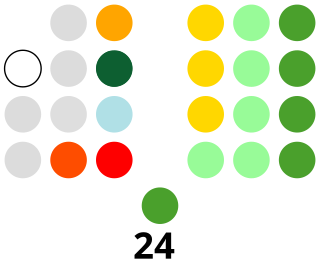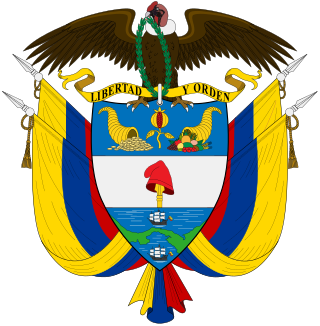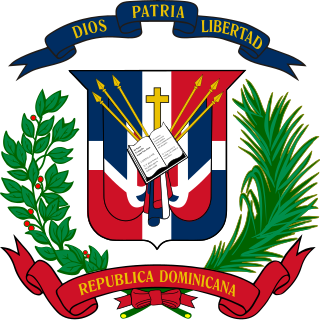
Article One of the United States Constitution establishes the legislative branch of the federal government, the United States Congress. Under Article One, Congress is a bicameral legislature consisting of the House of Representatives and the Senate. Article One grants Congress various enumerated powers and the ability to pass laws "necessary and proper" to carry out those powers. Article One also establishes the procedures for passing a bill and places various limits on the powers of Congress and the states from abusing their powers.

Article Two of the United States Constitution establishes the executive branch of the federal government, which carries out and enforces federal laws. Article Two vests the power of the executive branch in the office of the president of the United States, lays out the procedures for electing and removing the president, and establishes the president's powers and responsibilities.

The federal government of the United States is the national government of the United States, a federal republic located primarily in North America, composed of 50 states, five major self-governing territories, several island possessions, and the federal district and national capital of Washington, D.C., where most of the federal government is based.

The Constitution of the Confederate States was the supreme law of the Confederate States of America. It was adopted on March 11, 1861, and was in effect from February 22, 1862, to the conclusion of the American Civil War. The Confederacy also operated under a Provisional Constitution from February 8, 1861, to February 22, 1862. The original Provisional Constitution is located at the American Civil War Museum in Richmond, Virginia, and differs slightly from the version later adopted. The final, handwritten Constitution is located in the Hargrett Rare Book and Manuscript Library at the University of Georgia. Most of its provisions are word-for-word duplicates from the United States Constitution; however, there are crucial differences between the two documents in tone and legal content, primarily regarding slavery.
A constitutional amendment is a modification of the constitution of a polity, organization or other type of entity. Amendments are often interwoven into the relevant sections of an existing constitution, directly altering the text. Conversely, they can be appended to the constitution as supplemental additions, thus changing the frame of government without altering the existing text of the document.

The Congress of the Philippines is the legislature of the national government of the Philippines. It is bicameral, composed of a lower body, the House of Representatives, although colloquially the term "Congress" commonly refers to just the latter, and an upper body, the Senate. The House of Representatives meets in the Batasang Pambansa in Quezon City while the Senate meets in the GSIS Building in Pasay.

The Georgia General Assembly is the state legislature of the U.S. state of Georgia. It is bicameral, consisting of the Senate and the House of Representatives.

The New Jersey Legislature is the legislative branch of the government of the U.S. state of New Jersey. In its current form, as defined by the New Jersey Constitution of 1947, the Legislature consists of two houses: the General Assembly and the Senate. The Legislature meets in the New Jersey State House, in the state capital of Trenton.

The Congress of the Republic of Colombia is the name given to Colombia's bicameral national legislature.

The Congress of the Dominican Republic is the bicameral legislature of the government of the Dominican Republic, consisting of two houses, the Senate and the Chamber of Deputies. Both senators and deputies are chosen through direct election. There are no term limits for either chamber.

The president of the Republic of Texas was the head of state and head of government while Texas was an independent republic between 1836 and 1845.
The Constitution of the State of Tennessee defines the form, structure, activities, character, and fundamental rules of the U.S. State of Tennessee.

The Constitution of the State of Texas is the document that establishes the structure and function of the government of the U.S. state of Texas, and enumerates the basic rights of the citizens of Texas.
The Constitution of the Republic of Texas was the supreme law of Texas from 1836 to 1845.
The Constitution of the State of New Hampshire is the fundamental law of the State of New Hampshire, with which all statute laws must comply. The constitution became effective June 2, 1784, when it replaced the state's constitution of 1776.

Federalist No. 59 is an essay by Alexander Hamilton, the fifty-ninth of The Federalist Papers. It was first published by The New York Packet on February 22, 1788, under the pseudonym Publius, the name under which all The Federalist Papers were published. This is the first of three papers discussing the power of Congress over the election of its own members, the other two papers in this series being Federalist No. 60 and Federalist No. 61. The title of the paper is "Concerning the Power of Congress to Regulate the Election of Members".

The Legislature of the State of Oklahoma is the state legislative branch of the U.S. state of Oklahoma. The Oklahoma House of Representatives and Oklahoma Senate are the two houses that make up the bicameral state legislature. There are 101 state representatives, each serving a two-year term, and 48 state senators, who serve four-year terms that are staggered so only half of the Oklahoma Senate districts are eligible in each election cycle. Legislators are elected directly by the people from single member districts of equal population. The Oklahoma Legislature meets annually in the Oklahoma State Capitol in Oklahoma City.

The Constitution of the State of Oklahoma is the governing document of the U.S. State of Oklahoma. Adopted in 1907, Oklahoma ratified the United States Constitution on November 16, 1907, as the 46th U.S. state. At its ratification, the Oklahoma Constitution was the most lengthy governing document of any government in the U.S. All U.S. state constitutions are subject to federal judicial review; any provision can be nullified if it conflicts with the U.S. Constitution.
Impeachment in the Philippines is an expressed power of the Congress of the Philippines to formally charge a serving government official with an impeachable offense. After being impeached by the House of Representatives, the official is then tried in the Senate. If convicted, the official is either removed from office or censured.

Federal impeachment in the United States is the process by which the House of Representatives brings charges against a civil federal officer, the vice president, or the president for misconduct alleged to have been committed. The United States House of Representatives can impeach a party with a simple majority of the House members present or such other criteria as the House adopts in accordance with Article One, Section 2, Clause 5 of the United States Constitution. Most state legislatures can impeach state officials, including the governor, in accordance with their respective state constitution.












